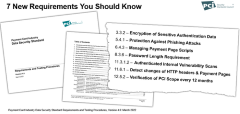

Trace All Merchant Chargebacks to 3 Basic Sources
Even if you haven’t had serious issues with them first-hand, you’re probably aware of chargebacks to at least some degree.
In case you’re unfamiliar, though, a chargeback is a form of payment reversal conducted at the bank level. If a cardholder has been the victim of fraud, or if there is some other issue that they’re unable to resolve through you directly, that person may contact the bank and request a chargeback. The issuer then reviews the situation and either rejects the claim, or claws back the funds on the cardholder’s behalf.
Each chargeback filed against you translates to lost sales revenue and merchandise. You could also see higher overhead (shipping costs, transaction fees, etc.), and get hit with a separate chargeback fee to cover the cost of administering the dispute. Over time, these chargebacks can cause other serious problems, potentially putting your entire business in jeopardy.
So, chargebacks are no laughing matter. But, then again, all you need to do is look at the chargeback reason codes published by Visa and Mastercard, identify chargeback triggers associated with those codes, and block them before they cause a dispute…right?
Unfortunately, it’s not that simple, because not all chargebacks are legitimate. It’s a problem that can’t be fixed by conventional fraud management tactics, or by looking at chargeback reason codes.
3 Chargeback Sources to Know
Identifying chargebacks by their source is a complex issue. There are dozens of different reason codes, all spread across different card brands. Further complicating matters, most true chargeback reasons are not reflected by the reason code.
Despite all the reason codes, the truth is that there are just three fundamental chargeback sources:
- Merchant Error: Seemingly-minor errors and missteps in policy and procedure than may result in a customer complaint.
- Criminal Fraud: Bad actors masquerading as legitimate cardholders in order to make purchases on the cardholder’s behalf.
- Friendly Fraud: Cardholders claiming chargebacks without a valid reason to do so; may be intentional or by accident.
You’d probably assume that most chargebacks occur as a result of criminal activity. However, data from Chargebacks911® suggests that less than 10% of all chargebacks are tied to criminal fraud. In reality, between 60-80% of all disputes are potential cases of friendly fraud.
Part of the problem is outdated industry procedures. Reason codes, for instance, can’t help with these cases; friendly fraud is premised on cardholders abusing the chargeback process, meaning any reason code attached to the claim would be misleading.
As noted above, friendly fraud could be the product of a simple error or misunderstanding on the cardholder’s part. For instance, the buyer doesn’t understand your shipping policies, and gets confused when a shipment of goods fails to arrive by the anticipated date. Another common problem is the billing address that appears on the cardholder’s statement. If buyers can’t recognize your name when it appears on their statements, they might assume it’s fraudulent and dispute the charge.
How to Prevent Chargebacks by their Source
This raises the question: what can you do to stop chargebacks? The solution is to take steps to identify each chargeback by its source, then deploy the right solution to address the problem.
Merchant Error
You have to perform a top-to-bottom examination of all policies and procedures in every facet of the business. Site design, order fulfillment, customer service, merchant policies—any one of these aspects of the organization could result in chargebacks if not handled exactly right.
Some of the most common errors that result in chargebacks include:
- Faulty return authorization policies
- Terms governing defective or damaged merchandise
- Billing descriptors that don’t accurately describe the transaction
- Charging customers for incorrect amounts
- Mismatches in customer shipping information
- Inaccurate or incomplete product descriptions
Criminal Fraud
The best approach to managing criminal fraud is to adopt a multilayer strategy. You can’t rely on one or two fraud detection tools; you need a host of complimentary tools that can give you a much more detailed, clear impression of whether to accept or reject a purchase. We recommend employing:
- CVV verification
- Address verification
- 3-D Secure 2.0 (or most recent version)
- Fraud blacklists
- Geolocation
- Velocity limits
…just to name a few. You can then deploy fraud scoring technology to compile all of these indicators and generate simple “yes” or “no” decisioning on whether to accept or reject a purchase.
Friendly Fraud
Because friendly fraud only becomes “fraud” in the weeks—or even months—after a sale, your options are limited in terms of prevention. There are some steps you can take that might prevent accidental chargeback abuse, such as sending order confirmation emails, updating customers about shipments status, and requiring signature confirmation for high-value items. However, the best response for friendly fraud is the chargeback representment process.
Representment involves compiling documentation and evidence that can undermine the cardholder’s claim. You have a small window of time in which to collect and submit this information, though. With representment, you must carefully study and understand all procedures outlined by the card network; but, even then, there’s no guarantee of success. This fact leads many merchants to choose to outsource the entire representment process to a chargeback management service.
Take on All Chargeback Sources
It’s important to understand the sources of chargebacks and why they plague merchants more and more each year. However, knowing why chargebacks happen is just the first step.
You have to take action against all three chargeback sources—merchant error, criminal fraud, and friendly fraud. Otherwise, the threat posed by payment disputes will only get worse with time.



